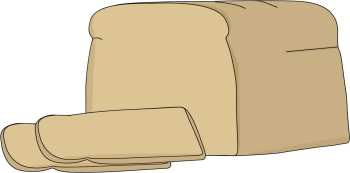Dramatic Play - Grocery Store/Bakery
Description

This is a loaf of bread with two slices laying down.
The dramatic play center provides opportunities for students to collaborate, engage in learning, and build language skills through conversations. Children have the opportunity to role play real-life experiences by taking on many roles in imaginative play. Utilization of the space as a store or bakery encourages students to take roles as a store owner, baker, cashier or customer and explore experiences in relation to these roles. Students are making shopping decisions, taking orders, preparing food, checking out customers and using money to pay to their items. Children engage in taking turns with peers and developing vocabulary through interactions with one another.
Purpose
- fine motor skills with preparation of food and handling of money
- math skills with the calculation of costs of the items/food and exchange of money
- sorting of items or food by color, size or type
- decision making opportunities
- writing opportunities for customer to write shopping list
- expression of artistic ability through drawing of items or food
- print exposure to names of items or food with labels on them
- language opportunities by using telephone to talk to customers and order supplies
- reading opportunities with exposure to variety of store/bakery related books in center
- expression of feelings and emotions
- creativity, imagination, abstract thinking
- oral communication, vocabulary
- cooperation, sharing, taking turns
Suggested Materials
- labels on baskets/shelves for items/food available for purchase (may include picture, word and price)
- variety of play food, empty boxes of cereal, tissues etc., play bakery items, etc.
- cash register with play money
- baskets, shelves or other materials for items/food to sit in or on
- play stove, oven, sink, refrigerator, mixing bowls, baking pans, cooking utensils for baker to prepare bakery items
- baker hat and apron, apron or name tag for cashier
- oven mittens, etc. to be used for handling "hot" items from oven
- kid friendly recipe for cakes, doughnuts, muffins, etc. for bakery
- checkout area for cashier to checkout customers and "bag" or "box" items/food
- play shopping cart/tote for customers to place items/food in while shopping, if available
- telephone
- sign identifying store/bakery open or closed
- writing utensils
- paper, clipboards, notepads to take order of customers
- reading materials - store/bakery related books in center, including nonfiction and fiction
Questioning Examples
These guiding questions can be used to assist the teacher, instructional assistant, or parent volunteers in supporting children's development and learning during play.
- Why did you choose that item to order? What do you like about it?
- Why are you buying those items?
- Do you like to be the customer, the cashier or baker in this center? Why?
- Where did all of these items come from? How can you get more if you need it?
- What kind of store would like to open and what would you like to sell?
- What will you do with the money you make from your job?
Considerations
This center can be set up with the following areas included: if bakery - kitchen area for baker to prepare food (play oven, stove, sink, refrigerator, food, baking pans, bowls, measuring and mixing tools), checkout area (with cash register, bags, boxes, telephone) for cashier to ring up orders and shopping area for customers with items/food on shelves or in baskets A basket/tote with books about stores/bakeries should also be in the center for students to explore. In addition, supply writing prompt papers for customers to have the opportunity to write their shopping list and/or a drawing of the list (see attached prompt). Also, encourage children to try different roles of customer, store owner, cashier or baker.
This center should allow for enough space for at least three students to play with the furniture and props. The dramatic play center should be located in an area of the room that enables students to communicate without disrupting other children's work and play.
Photo Examples
Literature Connections
Many literature connections exist for this topic and can be read to students before introduction of the center or during learning of the theme of store/bakery. These books can also be placed in the store/bakery center for independent exploration by the children. The following are a few suggestions:
"At the Supermarket" by Anne Rockwell
"Vikings in the Supermarket" by Nick Sharratt
"The Supermarket Mystery" by Richard Scarry
"Maisy Goes Shopping" by Lucy Cousins
"Mac A. Roni Visits the Supermarket" by Jessica Braithwait
"Mr. Cookie Baker" by Monica Wellington
"Sweet: Inside a Bakery" by Lisa Greathouse
"Bread Around the World" by John Serrano
"Walter the Baker" by Eric Carle
"Daniel's Sweet Trip to the Bakery: A Scratch and Sniff Book" by Maggie Testa
Downloadable Resources
These are center signs to be used at the store and a writing prompt for writing and illustrating a shopping list at the store.
This is a center sign to be used at the bakery.
This is a writing prompt for writing and illustrating shopping list at the bakery.
Clip art credit: www.mycutegraphics.com